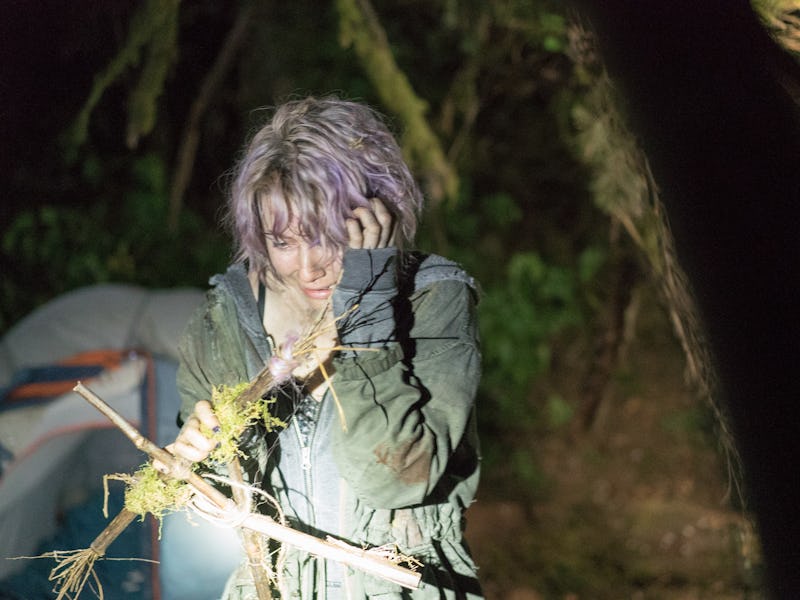How Adam Wingard Scared the Shit Out of His 'Blair Witch' Actors
Director Adam Wingard talks to Inverse about how he made a suitable sequel to the 20th century's last great horror movie.

17 years have passed since The Blair Witch Project scared moviegoers shitless. As the pioneering found footage, first-person movie released at the dawn of the internet and the end of analog tape, Daniel Myrick and Eduardo Sanchez’s found footage flick left a lasting and complicated legacy. It also left an impression on a teenager named Adam Wingard, who grew up to direct You’re Next, The Guest, and chapters of V/H/S, all new midnight staples in the Netflix age. When the opportunity to direct the latest reimagining of the franchise, Blair Witch, came about, Wingard knew that he and collaborator Simon Barrett were the right filmmakers for the job.
“In a lot of ways, the first thing I thought of when [Blair Witch] was offered was what I wanted out of the sequel and didn’t get,” Wingard told Inverse. Wingard, like many fans, didn’t like the poorly-conceived sequel Book of Shadows or many of the bevy of Blair Witch imitators that followed. “The legacy of Blair Witch was so tarnished by the inadequate sequel. I was really disappointed in the straightforward, meta-direction. I didn’t feel somebody else would take the kind of care and love to it we did. There was almost this responsibility of like, ‘Let’s set this back on track because there’s a way you can.’”
Once they got the gig, they knew expectations would be sky high and that what they did before, even in their own found footage work like V/H/S, wouldn’t cut it here. So the duo set out to re-educate themselves on what makes movies scary. What they found was so simple, it’s kind of frightening.
“I discovered that to actually have characters in the film be scared, it can’t be artificial,” Wingard says. “A lot of times when you see actors in a jump scare, they’re actually scared because I’m doing something on set surprising them.”
Wingard’s discovery sounds like a no-brainer, but the lengths the Blair Witch crew went to achieve that was, in its own way, a terrifying ordeal. In one instance, in the climax of the film, a character named Lisa (Callie Hernandez) crawls through a tight tunnel while the film’s dark forces aren’t far behind.
“For that moment to be real, because it’s all about her performance, we built this tunnel about 60 feet long. The only way to get from one side of the tunnel to the other is to crawl the whole thing.” Measured just one inch longer than Hernandez’s shoulder width, there wasn’t a lot of room to breathe or rest. The claustrophobia in the final cut is palpable.
“Her reactions are actually real,” Wingard says. “She’s in that space and it’s freaky. There’s a couple camera operators who had to crawl in there for shots, a couple of them had panic attacks. It was truly terrifying.”
Callie Hernandez as "Lisa" in 'Blair Witch.' Callie told Inverse in a separate interview that Adam liked to abuse his "scare horns," to the horror/delight of the cast and crew.
Another structure proved daunting: the Blair Witch’s house, which the filmmakers felt was the most important aspect to nail in the sequel. “There was a lot of discussions early on about how much is too much,” Wingard explains. “We wanted elements of the house to mimic the 1999 version. We wanted other aspects to be this morphing puzzle where you don’t know where you are and things change. That’s the idea, the house changes when different people go into it.”
Coming up with rules to dictate the house’s changes was its own challenge, as the found footage form allowed for more wiggle room than they actually wanted. “We wanted [changes] to always be off-screen because once you show too much, you start losing the reality. It was always [difficult] trying to find the balance in that kind of stuff.”
Other tools were less comprehensive, but no less effective. “I had these air horns on set that I called my scare horns — jokingly — that I could use to get a real jolt out of the actors.”
Adam Wingard, on set of 'Blair Witch.'
To Wingard, the method to his madness was to achieve reality in the moment, something he never tried before Blair Witch. His indie darlings You’re Next and The Guest pay homage to ‘70s and ‘80s horror, but they also incorporate black comedy and sci-fi. It’s an approach that Wingard intends to take again when he adapts the hit anime Death Note. “People have called me a horror filmmaker, but you could say I’ve never made a full horror movie before,” says Wingard. “That’s the thing that I learned, how to make a horror film. It has to be real, at least to the point you’re getting magic on set. You hear the phrase ‘cheap jump scares;’ there’s no such thing. A jump scare is one of the hardest things you can do. Sometimes you get lucky, but there’s a lot of timing and skill to making those work.”
If nothing else, Wingard’s final challenge was to satisfy the first film’s mystery of almost two decades: Why are the victims in the corner? Blair Witch answers that question … sort of. “That’s the fun thing,” Wingard says. “We never actually answer questions. All we give are characters’ theories, what they think is working and not. Nothing is what it seems.”
One of the most potent elements critics found at work in the original The Blair Witch Project was its ambiguity; audiences had to fill in the blanks with their own imagination. Wingard kept that going. “We give you ideas and some of them are conflicting, especially the mythology. We want people to make up their own idea of what it is.”
Blair Witch opens in theaters September 16.